April 2023
Saving Monticello: The Newsletter
The latest about the book, author events, and more
Newsletter Editor - Marc Leepson
Volume XX, Number 4 April 2023
“The study of the past is a constantly evolving,never-ending journey of discovery.” – Eric Foner

URIAH LEVY’S BUSINESSDEALINGS: Peopleoften ask me how Uriah Levy, a U.S. Navy lieutenant, had the means to buyThomas Jefferson’s Monticello in 1834, and then oversee repairing and restoringit, and then run the house and plantation until his death in 1862. The shortanswer is that Levy, who was born in 1892 and started his Navy career in 1812,made a small fortune mainly through savvy real estate dealings in New York.
As I wrote in Saving Monticello, whenthe 35-year-old Navy lieutenant (inuniform, in the painting below, circa 1815) moved to New York City inJanuary 1828, he began investing in real estate. That year he bought threerooming houses in Greenwich Village, two on Duane Street and one on GreenwichStreet. Levy subsequently purchased seven additional rooming houses in theVillage and elsewhere in lower Manhattan. It was a propitious time to do so.
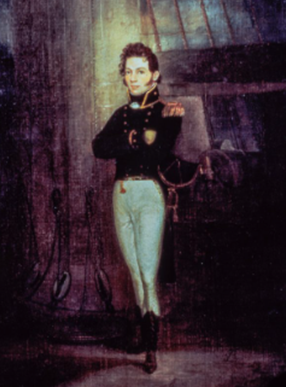
GreenwichVillage experienced a growth spurt in the 1820s. As the old farming village’s streetswere paved and sidewalks flagged, the area’s population increased, property values rose and hundreds of new businesses opened. Itbecame home to carpenters, masons, painters, stonecutters, and otherblue-collar workers, soon followed by middle-class merchants and tradesmen.
Levyamassed a not inconsiderable fortune through his New York City real estateholdings. In 1855, he was listed as one of the wealthiest men in Manhattan in MosesY. Beach’s The Wealth and Biography ofthe Wealthy Citizens of the City of New York. Beach estimated Levy to beworth $500,000. He and August Belmont (1816-90), the German-born banker anddiplomat, were the only Jewish people on Beach’s list.
That was the extent of my knowledge about Uriah Levy’s business dealings—untila few weeks ago. That’s when I received an email from Lori Kimball, a historianand archivist who specializes in the history of Loudoun County, Virginia—wherewe both live.
Loritold me that in her work in the Historic Records Room at the Loudoun CountyCourthouse in Leesburg she and her colleague Eric Larson had come across twodocuments that showed that Uriah P. Levy had other business dealings aside fromthose in New York City.
Onewas a May 17, 1834, Deed of Trust, in which Uriah Levy “in the Navy of theUnited States,” his cousin Mordechai Noah, and a man named James Monroe (notthe President, who lived in Loudoun, but had died in 1831), “both of the cityof New York,” loaned $6,000 to a prominent Loudoun County citizen, George Rust,and his wife Maria Clagett Rust.
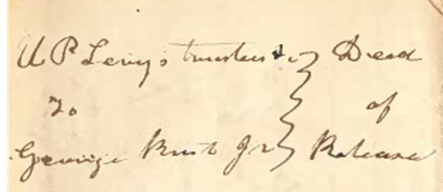
TheRusts put up three piece of property as collateral for the loan: Rockland, his 503-acrecountry home outside Leesburg, a parcel of land in the town of Leesburg, and a44-acre tract on the Potomac River. They made the semi-annual 7 percentinterest payments on the loan for nearly six years. Then, as a February 3,1840, Deed of Release (in the above image)showed, George Rust paid back the principal four years later, and Levy andcompany released the properties.
Thisfairly high-level business deal led me to two questions. Was U Uriah Levy inthe habit of lending money? And did he venture to Loudoun County in May1834—about a month after he purchased Monticello? Going through my researchmaterials accumulated over the last 25 years, I was unable to find the answerto either question.
Mysupposition is that it’s unlikely this was the only such loan Uriah Levy madeand that he could have been in Loudoun at this time as we know that he was inAlbemarle County about a hundred miles south of Leesburg in the spring of 1834.
Butthat’s conjecture, and I will continue to look for evidence of Levy’s otherbusiness dealings and his travels to the northwestern part of Virginia. Staytuned.
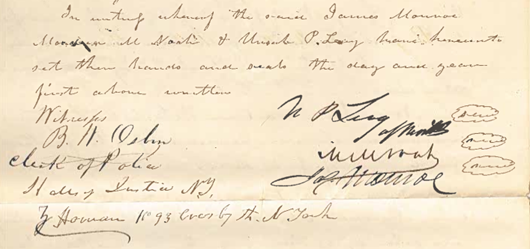
Postscript: On the signature page ofthe Deed of Trust, as you can see in the image above, Uriah Levy (barelylegibly) signed his name, “U.P. Levy of Monticello.”
THERIMONIM, PART II: Last month Ireported on the two ornate eighteenth century silver Torah finials called Rimonimthat had been at the center of a dispute between Congregation Shearith Israel inNew York and Touro Synagogue in Newport, Rhode Island. I mentioned that theyhad been on loan to the Boston Museum of Fine Arts, and illustrated the postingwith a generic image of Rimonim. Then I learned, through emails from attentivenewsletter subscribers, that the finials are still on display at FMA, and thatthe Museum’s website includes a photo (below)of them, along with excellent interpretation, which provides more details aboutthe unique—and valuable—objects.
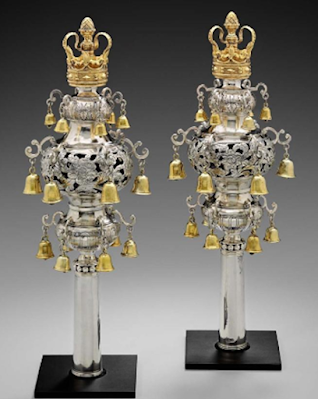
The Rimonims’finial bells make “festive sounds when they are carried around the synagogue,”the museum notes. “Their Hebrew name ‘Rimonim’ means pomegranates, because ofthe round shape recalling the biblical symbolic fruit.
“This splendid pair, on loan from Congregation Shearith Israel in New York(est. 1654), is an exceptionally rare example of colonial American Judaica.They were made by Myer Myers, a Jewish silversmith who led the market in18th-century New York.” Myers “produced luxury silverware for both domestic andreligious use for [his] Jewish and non-Jewish clients.
“These finials hold a very special place in Jewish American history…. They were… probably in the Newport synagogue during GeorgeWashington’s famous visit on August 18th, 1790. Today the New York congregationuses the beautiful Rimonim during the High Holidays.”
The U.S.S. LEVY: As I reported in Saving Monticello, the first time theUnited States Navy honored Uriah Levy’s exceptional 50-year naval careercame during World War II when a destroyer escort was christened the USS Levy.
That ship, one of the first of its kind in the Navy, servedin the southern and central Pacific from August 1943 through the end of the wartwo years later, seeing action in many engagements, including the two-monthBattle of the Philippine Sea in the summer of 1944.
In August and September 1945 the ship’s officers took partin surrender ceremonies of the Japanese Navy in the southeastern MarshallIslands. They negotiated and accepted the surrender of Mille (sometimes spelledMili) Atoll on August 21 and witnessed the surrender of Jaluit Atoll later thatmonth. On September 4, the Japanese officially surrendered Wake Island toMarine Corps Brig. Gen. Lawson. H. M. Sanderson aboard the Levy.
Not long after Saving Monticello came out inNovember 2001, my friend Julie Coles told me that her late father, Daniel F.Evans, had served as a 22-year-old gunnery officer on the ship during the war.And that he took part in the surrender ceremonies. Then, just last week, shesent me the image at left that her father kept in his scrapbook.
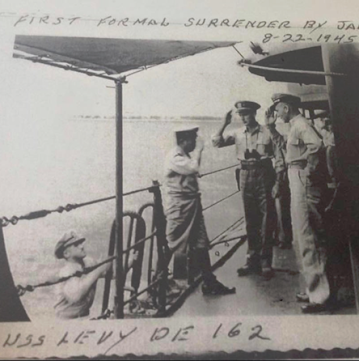
That’s Daniel Evans with the binoculars around his neck,saluting one of the three Japanese officers who came on board on August 21,most likely Navy Capt. Masanori Shigaone
Julie told me that her fathersaid that he and Lt. Cmdr. William Clarenback (to Evans’ left) were chosen to greet the Japanese officers because theywere tall men and their commanding officer Capt. Harold B. Grow wanted themthere to tower over and humiliate the Japanese.
She also said her father toldher that after the picture was taken the officer committed ritual suicide.
You can find more info on theU.S.S. Levy during World War II ontwo excellent, well-illustrated web sites: https://bit.ly/USSLevyand https://bit.ly/4USSLevyPhotos
THE DOC:Steven Pressman’s great documentary, “The Levysof Monticello,” which was inspired by SavingMonticello, continues to appear at film festivals across the country.
On Wednesday, April 19, there’ll be an in-personscreening at the Center for Jewish History at the American Jewish HistoricalSociety in New York City. For details, go to: https://bit.ly/AJHSLevys
Wehad a screening on March 14 at TheHill School in Middleburg, Virginia, where I live, sponsored by our town’slibrary friends group, the Middleburg Library Advisory Board. It was a greatevent, after which I took questions from the audience and then signed copies ofthe book at the best book-signing table I’ve ever had, which was set up by alocal shop, Crème de la Crème. Yes, that’s a lamp, a potted plant, and twotable cloths adorning the table.
EVENTS: Here are details about my four events in April:
· Sunday, April 2, talk on SavingMonticello, and book signing at Congregation Beth Am Israel in Penn’sLanding, Pennsylvania.
· Tuesday, April 11, talk for the Sons of Confederate Veterans Camp, in Winchester,Virginia, on my only Civil War book, Desperate Engagement
· Saturday, April 15, talk at historic City Tavern in Washington,D.C. on the life of Francis Scott Key, sponsored by the City Tavern Preservation Foundation. This is a free event and is open to thepublic, with registration required through Eventbrite at https://www.eventbrite.com/e/551699807977
· Sunday,April 16, talk on Desperate Engagement for the Washington, D.C., chapter ofthe Daughters of theUnion Veterans of the Civil War
If you’dlike to arrange an event for SavingMonticello or for any of my other books, email me at marcleepson@gmail.comFor details on other upcoming events, check the Events page on my website: https://bit.ly/NewAppearances
GIFT IDEAS: For a personally autographed, brand-new paperback copy of Saving Monticello, please e-mail marcleepson@gmail.com I also have a few as-new, unopened hardcovercopies, along with a good selection of new copies of my other books: Flag: An American Biography; DesperateEngagement; What So Proudly We Hailed; Flag:An American Biography; and Ballad ofthe Green Beret: The Life and Wars of Staff Sgt. Barry Sadler.



